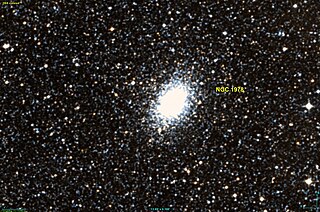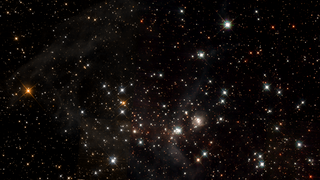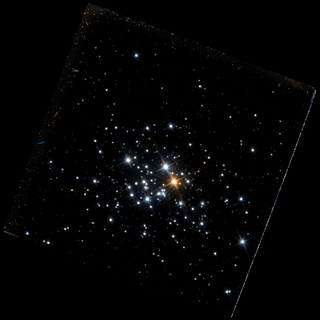
Dorado is a constellation in the southern sky. It was named in the late 16th century and is now one of the 88 modern constellations. Its name refers to the dolphinfish, which is known as dorado in Portuguese, although it has also been depicted as a swordfish. Dorado contains most of the Large Magellanic Cloud, the remainder being in the constellation Mensa. The South Ecliptic pole also lies within this constellation.

The Tarantula Nebula is an H II region in the Large Magellanic Cloud (LMC), from the solar system's perspective forming its south-east corner.

NGC 2070 is a large open cluster and candidate super star cluster forming the heart of the bright region in the centre-south-east of the Large Magellanic Cloud. It is at the centre of the Tarantula Nebula and produces most of the energy that makes the latter's gas and dust visible. Its central condensation is the star cluster R136, one of the most energetic star clusters known. Among its stars are many of great dimension, including the second most massive star known, R136a1, at 215 M☉ and 6.16 million L☉.

NGC 1903 is a star cluster in the Large Magellanic Cloud in the constellation Dorado. It was discovered in 1834 by John Herschel with an 18.7-inch reflecting telescope.

NGC 361 is an open cluster in the Small Magellanic Cloud. It is located in the constellation Tucana. It was discovered on September 6, 1826 by James Dunlop. It was described by Dreyer as "very very faint, pretty large, very little extended, very gradually brighter middle."

NGC 1873 is an open cluster associated with an emission nebula located in the Dorado constellation within the Large Magellanic Cloud. It was discovered by James Dunlop on September 24, 1826 and rediscovered by John Herschel on January 2, 1837. Its apparent magnitude is 10.4, and its size is 3.50 arc minutes.

NGC 1936 is an emission nebula which is part of the larger LMC-N44 nebula located in the Dorado constellation in the Large Magellanic Cloud by John Herschel in 1834 which was added to the Catalogue of Nebulae and Clusters of Stars as NGC 1936 and was observed by John Dunlop on September 27, 1936 and Williamina Fleming in 1901 which was later added to the Index Catalogue as IC 2127. Its apparent magnitude is 11.60.

NGC 1929 is an open cluster associated with the emission nebula located within the N44 nebula in the Dorado constellation and part of the Large Magellanic Cloud. It was discovered by James Dunlop on August 3 1826. Its apparent magnitude is 14.0, and its size is 0.8 arc minutes.

NGC 1935 is an emission nebula which is part of the larger LMC-N44 nebula in the Dorado constellation. NGC 1935 is also located in the Large Magellanic Cloud. It was discovered by John Herschel in 1834 which was added to the Catalogue of Nebulae and Clusters of Stars as NGC 1935 and was observed by Williamina Fleming in 1901 and was later added to the Index Catalogue as IC 2126.

NGC 1978 is an elliptical shaped globular cluster or open cluster in the constellation Dorado constellation. It is located within the Large Magellanic Cloud. It was discovered by James Dunlop on November 6, 1826, and its apparent magnitude is 9.9, and its size is 3.9 arcminutes. Its radial velocity is 293.1 ± 0.9 km/s.

NGC 2002 is an open cluster located in the Dorado constellation and is part of the Large Magellanic Cloud. It was discovered by James Dunlop on September 24, 1826. Its apparent magnitude is 10.1, and its size is 2.0 arc minutes.

NGC 1955 is an open cluster associated with an emission nebula located in the Dorado constellation. This nebula is part of the H II region which is part of the Large Magellanic Cloud and was discovered by James Dunlop on August 3, 1826. Its apparent magnitude is 9.0, and its size is 1.8 arc minutes.

NGC 1971 is an open cluster which is in the Dorado constellation and is part of the Large Magellanic Cloud. It was discovered by John Herschel on December 23, 1834. Its apparent size is 11.9 by 0.80 arc minutes.

NGC 1959 is an open cluster located in the Mensa constellation which is part of the Large Magellanic Cloud. It was discovered by John Herschel on December 23, 1834. Its apparent magnitude is 12.2, and its size is 0.50 arc minutes.

NGC 1974 is an open cluster associated with an emission nebula which is located in the Dorado constellation which is part of the Large Magellanic Cloud. It was discovered by James Dunlop on November 6, 1826 and it was observed by John Herschel on January 2, 1837 which was later cataloged as NGC 1991. Its apparent magnitude is 9.0 and its size is 1.7 arc minutes.

NGC 1997 is an open cluster located in the Dorado constellation which is part of the Large Magellanic Cloud. It was discovered by John Herschel on November 30, 1834. Its apparent magnitude is 13.43 and its size is 1.80 arc minutes.
NGC 1994 is an open cluster in the Dorado constellation which is located in the Large Magellanic Cloud. It was discovered by John Herschel on 16 December 1835. It has an apparent magnitude is 9.8 and its size is 0.60 arc minutes.
NGC 1986 is an open cluster which is located in the Mensa constellation which is part of the Large Magellanic Cloud. It was discovered by James Dunlop on September 27, 1826. It has an apparent magnitude of 11.31 and its size is 2.80 by 2.40 arc minutes.

NGC 1983 is an open cluster associated with an emission nebula which is located in the Dorado constellation and part of the Large Magellanic Cloud. It was discovered by John Herschel on 11 November 1836. It has an apparent magnitude of 9.9 and its size is 1.0 arc minutes.

NGC 1984 is an open cluster associated with an emission nebula, it is located in the constellation Dorado in the Large Magellanic Cloud. It was discovered by John Herschel on 16 December 1835. The apparent magnitude is 9.9 and its size is 1.50 by 1.20 arc minutes.

















